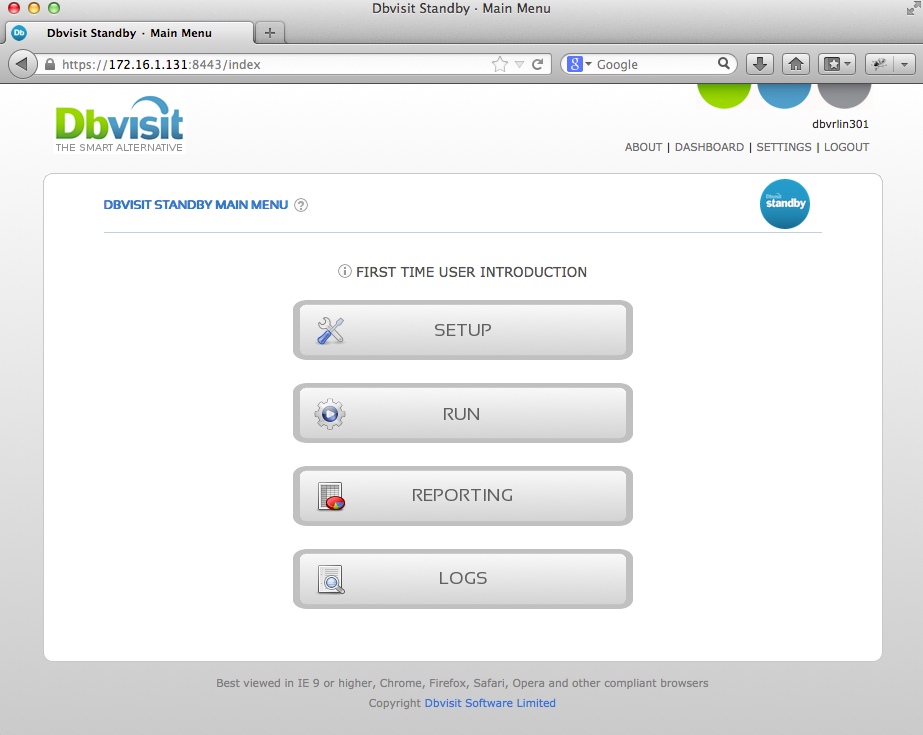| Table of Contents |
|---|
Dbvisit Standby version 7 is making use of a new directory structure in comparison to the previous version 5 and 6. The default location on Linux for version 5 and 6 was /usr/local/dbvisit but in version 7 the default location changed to /usr/dbvisit. You can however still install version 7 into any other custom location, example /opt/dbvisit. It is recommended not to install Dbvisit Standby in the home directory of the oracle Unix account (/home/oracle).
...
| Note |
|---|
When installing Dbvisit Standby in a Oracle RAC environment Oracle Grid Infrastructure version 11.1 and higher is recommended. Using version 10.2 for ASM storage is not recommended and will limit the functionality of Dbvisit Standby - Graceful Switchover will not be possible. |
Dbvisit Standby will be installed on all the servers in an Oracle RAC configuration. For example if you are using a four node cluster, you need to install Dbvisit Standby on all four nodes as well as on the Standby server(s).
...
| Note |
|---|
Before you continue with the next step you need to make sure you follow Step 1 to 5 above on all the servers in the standby configuration. When doing this, it is important to make sure the Dbvnet password provided during installation is the same on all the servers where you are installing Dbvnet. This password is used for secure communication and if different passwords are used between the primary and standby servers, you will not be able to establish a connection between these servers using Dbvnet. |
Step 6: Testing Dbvnet Communication
...
| Align | ||||||||||||||
|---|---|---|---|---|---|---|---|---|---|---|---|---|---|---|
Dbvisit Standby considerations with RACThe Dbvisit Standby Database Configuration file (DDC) created during the setup on each node will have the name of the instance and not the name of the database (dbv_oracle_instance.env).
Dbvisit Standby RAC TakeoverIf a RAC node fails and is unavailable, then Dbvisit Standby on another RAC node can automatically take over the log shipment from the failed node. The Dbvisit Standby RAC Takeover is controlled by the following variables in the dbv{_}oracle_instance.env file:
RAC_TAKEOVER:
RAC_TAKEOVER_FORCE:
RAC_TAKEOVER_SID
Example - 2 Node Primary RAC configuration If the RAC setup contains 2 nodes (racnode1, racnode2) with instance names RACDB1 and RACDB2, then:
Example - 3 Node Primary RAC Configuration The RAC_TAKEOVER_SID is not too different with a 3 node set up, as for a 2, and you just specify the next node in the sequence in a rolling/circular fashion. So, if the RAC setup contains 3 nodes (racnode1, racnode2, racnode3) with instance names RACDB1, RACDB2 and RACDB3 then:
|
Step 6: Testing Dbvnet Communication
Once you have Dbvisit Standby installed on all the servers, it is important to make sure that the communication between the Primary and Standby servers are working. This can be done by making use of the Dbvnet Test utility provided with the Dbvisit Standby installation - dbvnet-test, which is located under the dbvnet sub directory. When using the default path this utility will be in /usr/dbvisit/dbvnet/dbvnet-test
...
- To perform a basic status check which confirms that the primary and standby server can communicate using Dbvnet:
- dbvnet-test [-s|--status] SERVER[:PORT]
- To perform a more detail check, testing network connectivity, you can run the following:
- dbvnet-test [-f|--fulltest] SERVER–fulltest] TMPDIR SERVER:PORT
In the example below, dbvrlin301 is a primary server and dbvrlin305 is the single instance standby server. Dbvisit Standby was installed using default values and no additional configuration has been performed at this stage. Dbvnet and Dbvserver is running on both nodes, but only Dbvnet is required and used for these tests:
...
| Code Block | ||
|---|---|---|
| ||
oracle@dbvrlin301[/usr/dbvisit/dbvnet]: ./dbvnet-test -f /tmp dbvrlin305:7890
>>> Determining Dbvnet status on server dbvrlin305:7890...
Dbvnet on server dbvrlin305:7890 is running.
>>> Running file transfer round trip on server dbvrlin305:7890...
Creating file '/tmp/dbvnet-test.tmp' containing 10 MB of data... - done.
> Transferring 'dbvnet-test.tmp' to server dbvrlin305:7890
Progress: 0%...20%...40%...60%...80%...100% [2609 KB/s] - done.
> Retrieving file "dbvnet-test.tmp" from server dbvrlin305:7890
Progress: 0%...20%...40%...60%...80%...100% [4599 KB/s] - done.
Comparing checksums: all three checksums (local/remote/local) are identical. File
transfer round trip finished successfully. |
...
To access this interface you can use http or https and the specified port you specified during installation. The default is https with port 8443 and you should be able to connect to the web based frontend using the following url: https://yourservername:8443
Example below is connecting to the GUI on dbvrlin301 (172.16.1.131) using https and port 8443.
When asked for a username and password you need to provide the username and password specified during installation.
Summary
If you followed the above steps you should now have Dbvisit Standby installed on both your primary and standby servers.
You are now ready to move on to the next step which is to configure Dbvisit Standby.yourservername:8443
Example below is connecting to the GUI on dbvrlin301 (172.16.1.131) using https and port 8443.
When asked for a username and password you need to provide the username and password specified during installation.
Summary
If you followed the above steps you should now have Dbvisit Standby installed on both your primary and standby servers.
You are now ready to move on to the next step, which is to configure Dbvisit Standby by creating Dbvisit Standby Configuration (DDC) files on the primary nodes
| Note | ||
|---|---|---|
| ||
DDC files should be created on the primary nodes - this is where the master copy of the DDC files are located and maintained. A copy of the DDC file will be transferred and maintained on the standby server by Dbvisit Standby. You should not manually create or modify the DDC file on the standby server. All DDC creation and changes should be made from the primary servers. |
